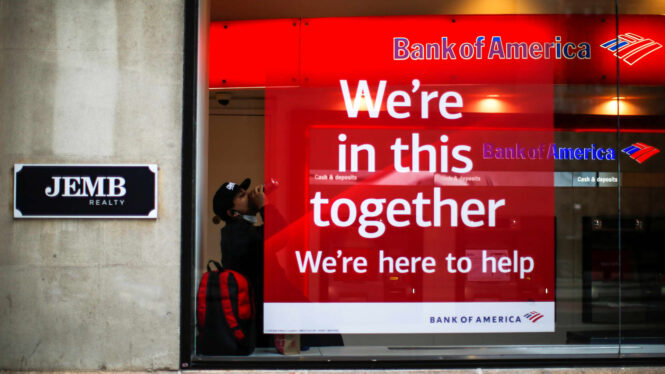
Financial institutions lastly obtained a long-awaited increase to rate of interest this year after a years of toiling in a low-rate atmosphere. It really did not go as intended. A year earlier, large lending institutions consisting of Financial institution of America as well as Wells Fargo were the leading choices of the expert neighborhood due to the fact that they were anticipated to gain from greater prices. Funding development combined with huge down payment bases would certainly drive gains in passion revenue as the Federal Get treked prices, the reasoning went. While that pattern played out, the bull situation was ruined by rising cost of living at four-decade highs, which required the Fed to increase prices greater than anticipated, activating worries of an economic crisis. In a recession, financial institutions are subjected to rising lending defaults, minimized lending need as well as write-downs on possessions. That’s why the KBW Financial institution Index sagged 23% via mid-December, even worse than the 17% decrease of the S & & P 500 as well as on course for its worst year given that 2008. “The passion rate-trade is obtaining aging, as well as at the same time there are unpredictabilities on down payments, both on expenses as well as discharges,” David Konrad, a KBW expert, informed CNBC in a phone meeting. He reduced his referral on the industry to market weight from obese recently. Internet passion revenue development will possibly come to a head in this year’s 4th quarter at 30% as well as depression to simply 5% by the end of 2023, Konrad stated in a Dec. 13 note. Amongst financial institutions, he prefers Goldman Sachs as well as Morgan Stanley due to the fact that “they have actually currently been running in an economic crisis” as well as their funding markets organizations will certainly rebound prior to retail financial does, he stated in the meeting. Several headwinds Headwinds encountered by financial institutions following year consist of assumptions for diminishing lending margins in the 2nd fifty percent, greater gets for negative car loans, climbing financing expenses for down payments, greater expenditures as a result of wage rising cost of living as well as proceeded stress on home mortgage, riches monitoring as well as financial investment financial earnings, according to Raymond James experts led by Daniel Tamayo. “With most of our favorable drivers from 2021-22 played out, our company believe 2023 will certainly be unstable for financial institution supplies, with the very best entertainers those that can endure headwinds for the market,” Tamayo stated in a Dec. 15 note. Tamayo prefers smaller sized financial institutions over megacaps for their reduced appraisals, much less stringent governing oversight as well as the opportunity of mergings. He has a solid buy ranking on Tempo Financial institution, Huntington Bancshares, First Republic as well as Wintrust Financial. Resist till 2024? Because blood vessel, Morgan Stanley expert Betsy Graseck encouraged that it was prematurely to go long big cap financial institutions. Financiers must load right into the industry just after lending misbehaviors top or the Fed finishes its equilibrium sheet-shrinking project referred to as measurable firm, she stated in a Dec. 6 note. “It’s insufficient for the Fed to simply slow down or quit treking prices, it needs to finish QT to obtain even more favorable on the financial institutions,” Graseck stated. That’s due to the fact that “we anticipate that credit score is most likely to stun even more adversely than favorably over the following one year as the economic situation handles still-high rising cost of living, greater loaning expenses” as well as climbing , she included. The delay might be long: Morgan Stanley economic experts see QT finishing in the initial fifty percent of 2024. The bull situation On the various other hand, the team might rally following year if the economic situation takes care of a soft touchdown or light economic crisis, Financial institution of America expert Ebrahim H. Poonawala stated in a Dec. 11 note. Much of the disadvantage for the market is currently installed in present appraisals, according to Baird expert David George. That might establish the inverse of 2022– a year in which pessimism brings about better-than-expected supply returns. Expert expert Mike Mayo of Wells Fargo stated that financial institution supplies might stand out 50% in 2023 by showing their strength in an economic crisis. That’s due to the fact that they have actually been de-risked over greater than a years of significantly rigorous economic guidelines. “We assume financial institutions must do much better in a future economic crisis than for any kind of various other in contemporary background,” Mayo stated in a Dec. 14 note. “What appears most underappreciated is the level that financial institution architectural adjustments over the previous years prepare the market for the intermittent difficulties in advance.” His leading choices are Financial institution of America, United State Bancorp as well as PNC Financial Providers. The 3 lending institutions are prepared to browse a recession with solid credit score high quality, reduced expenditures as well as greater performance, he stated.– CNBC’s Michael Blossom added to this record.
Related Posts:
- Financial institution of Spain cuts 2023 progress…
- The Factor, Oct. 17, 2022: Arise from a brand-new…
- Financial institution of America (BAC) Q3 2022…
- UN: 2022 most likely most dangerous for Palestinians…
- Financial institution of America (BAC) This autumn…
- October 2022 euro location financial institution…
